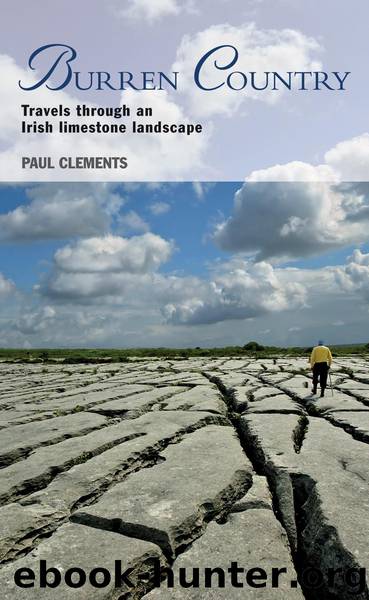Burren Country by Paul Clements

Author:Paul Clements
Language: eng
Format: epub
ISBN: 9781848899391
Publisher: The Collins Press
Published: 2011-08-14T04:00:00+00:00
Two centuries ago more than 800 people lived and farmed in Gleninagh; today fewer than forty people live in this area. Over the years on visits to try to get to know it and read its history, I have taken time to potter and ponder and have come to realise the sense of loss and abandonment which is found here. There is sadness to strolling around the fields and in imagining how it once had been. Even the cows have a mournful bellow.
To get a feel for the atmosphere of Gleninagh, a wander around it will open your eyes to the human history and the flora to be found in one small patch of land. Gleninagh, Gleann Eidhneach, translates as ‘Glen of the Ivy’ and the last Irish speakers in County Clare lived here. The townland (one of 2,176 in Clare and spelled on some maps and in books as Glaninagh) is divided into two territorial divisions north and south, and is equidistant between Ballyvaughan and Black Head. There is no coastal hamlet or village, but it is made up of scattered cottages and houses along the roadside and down lanes. Gleninagh North sits hard by the sea on a rock-strewn shore. Incorporated within this area of a few square kilometres are a deserted village, an abandoned tower house, a derelict medieval parish church, and the remains of the site of Gleninagh Lodge along with other unidentified skeletal ruins including forts. Historical sites litter the ground. Apart from the holy well, a close inspection reveals an ancient cooking place and a lime kiln within a few metres of each other.
It can be approached by two ways: either walking down a gently sloping lane used by the pilgrims, or by boat from the sea, but tourist coaches do not stop here and few boats moor at the quay where the Earl of Ormonde sailed into exile in 1639. Parking nearby is difficult, so the area is neglected by visitors and remains one of the Burren’s secrets. You will not find it in any modern guidebooks but in 1831 it was mentioned in Samuel Lewis’ topography of Ireland. In the 1840s Thomas L. Cooke of Parsonstown, who wrote a series ‘Autumnal Rambles about New Quay’ for the Galway Vindicator, visited the well. He described its walls of solid masonry and the interior as ‘having human skulls, and round flat stones resembling cakes of home-made bread’. It is also mentioned in Murray’s Handbook for Ireland (1906). The author John Cooke writes that at Gleninagh holy well a human skull was once used as a vessel for drinking but the practice was stopped by the parish priest.
Locals know its history and toponymy. Meet a farmer here and he will tell you that he comes from the townland of Gleninagh, in the parish of Ballyvaughan, in the diocese of Kilfenora, in the barony of the Burren, in the county of Clare, in the province of Munster, in the country of Ireland. Pride in place and
Download
This site does not store any files on its server. We only index and link to content provided by other sites. Please contact the content providers to delete copyright contents if any and email us, we'll remove relevant links or contents immediately.
In a Sunburned Country by Bill Bryson(3376)
Annapurna by Maurice Herzog(3304)
How to Read Nature by Tristan Gooley(3089)
Dangerous Girls by Haas Abigail(2844)
SAS Survival Handbook by John 'Lofty' Wiseman(2583)
The Lost Art of Reading Nature's Signs by Tristan Gooley(2550)
In the Woods by Tana French(2424)
The Stranger in the Woods by Michael Finkel(2331)
Food and Water in an Emergency by Food & Water In An Emergency(2273)
Guns, Germs and Steel by Diamond Jared(2206)
Wild: From Lost to Found on the Pacific Crest Trail by Cheryl Strayed(2145)
Everest the Cruel Way by Joe Tasker(2135)
Backpacker the Complete Guide to Backpacking by Backpacker Magazine(2111)
Trail Magic by Trevelyan Quest Edwards & Hazel Edwards(2064)
Ultimate Navigation Manual by Lyle Brotherton(2056)
Sea Survival Handbook by Keith Colwell(2045)
Welcome to the Goddamn Ice Cube by Blair Braverman(1888)
Birds of the Pacific Northwest by Shewey John; Blount Tim;(1876)
The Last Flight by Julie Clark(1844)
